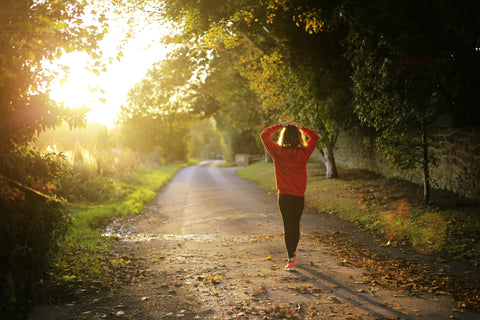Wende drehen: Bewegung in Jane Austens England

Wenn Sie in den früheren Stunden des Morgens, bevor der Pendlerschub ernsthaft begonnen hat, Ihren Kopf aus der Tür strecken, werden Sie vielleicht etwas Seltsames bemerken. In der Tat könnten Sie sich fragen, ob etwas Schreckliches passiert ist. Was rennt jeder?
Diejenigen von uns, die sogar einen einzigen fitnessorientierten Freund haben, können Ihnen sagen, dass die Marathon-Saison in vollem Gange ist, und in unseren Städten und Vororten fegt der laufende Bug durch Gemeinschaften, insbesondere von zwanzig und dreiunddreißig, die nach neuen Wegen suchen, um fit zu werden und Kontakte zu knüpfen. Am vergangenen Wochenende waren die Straßen von London mit Zehntausenden von Läufern und Zuschauern für den TCS London Marathon gefüllt, wobei viel mehr einstimmte, um die Aktion auf ihren Fernsehern zu beobachten. Wenn Sie überhaupt auf die Veranstaltung geachtet haben, fühlen Sie sich möglicherweise inspiriert. Heute fragen wir uns, was Jane Austen aus all dem laufenden Malarkey gemacht haben könnte. Schauen wir uns an.
Von Fußrassen zum Marathon
Was wir als den modernen Marathon betrachten - ein Rennen mit genau 26 Meilen und 385 Jahren - ist ein relativ jüngstes Phänomen. Der Marathon hat seinen Namen aus der Entfernung zwischen der griechischen Stadt Marathon und Athen, die laut Legend einen griechischen Soldaten lief, um die Stadt wissen zu lassen, dass die Griechen die persische Armee in der Schlacht am Marathon besiegt hatten, bevor er schnell tot fiel. Sie fragen sich, warum wir uns freiwillig dafür anmelden würden. Der moderne Marathon würde erst 1896 erfunden, als er als Veranstaltung in den ersten modernen Olympischen Spielen vorgestellt wurde, um den neuen Spielen einen Geschmack alter Spiele zu verleihen. Es wäre erst in den 1960er Jahren Frauen Würde in der Lage sein, am Marathon teilzunehmen, Es ist also mit Sicherheit zu sagen, dass, wenn Sie an Jane Austen in Ihren Hokas und Running Shorts vorbeigeschlagen haben, sie in der Tat sehr falsch war.
Dies bedeutet nicht, dass die Idee eines Fußrasses Jane Austen fremd wäre. Sie sind vielleicht mit der Tatsache vertraut, dass das Boxen zu dieser Zeit unglaublich beliebt war, zumal es Männern ermöglichte, ein schnelles Quid auf ihren Lieblingskämpfer zu machen (Fans von Bridgerton werden diese Praxis aus der ersten Staffel erkennen). Nun, das Laufen war nicht anders. In den späten 1700er Jahren wurde das sechstägige Rennen geboren. Es ist genau das, wonach es sich anhört - Sie gehen oder joggen, so weit wie möglich in sechs Tagen. Es wurde von einem Gentleman namens Foster Powell, einem begeisterten Wanderer, der 1773 beauftragt, die 200 Meilen zwischen London und York - und zu durchqueren - und zu verfolgen - und zurück - über sechs Tage. Obwohl er viele Kritiker hatte, wurde Powell bei seiner Rückkehr von einer Menge von über fünftausend Fans in London getroffen, nachdem er die 400 -Meilen -Distanz in der Distanz in den fünf Tage und achtzehn Stunden. Dies löste eine wettbewerbsfähige Mode aus, um zu sehen, wer Powell übertreffen konnte. Obwohl Austen vielleicht nicht von dem Marathon außerhalb ihrer Klassiker gewusst hat, war sie vielleicht mit dem Konzept vertraut, was eines Tages zum Ultramarathon werden würde.
Ladylike Anstrengung
Wie wir bereits festgestellt haben, konnten Frauen erst in den 1960er Jahren offizielle Marathons betreiben, und erst in den 70er Jahren wurde das Rennen für Fitness für alle Geschlechter trendy. Also, wenn Sie eine junge Frau in Jane Austens England wären, wie könnten Sie dann fit bleiben?
Natürlich war es immer notwendig, dass die Arbeiterklasse laufen - die Aufrechterhaltung von Pferden und Kutschen ist kostspielig. Für viele wäre es der einzig tragfähige Weg, sich fortzubewegen. In der Regentschaft galt es jedoch als richtig für junge Damen, einen Morgenspaziergang zu machen, und Kleider wurden speziell zum Gehen mit kürzeren Säumen zugeschnitten oder konzipiert, damit sie nicht über den Boden zogen.
Wir haben in unseren Beobachtungen häufig Gelegenheit gefunden, sich im gegenwärtigen Stil von weiblichen Kleidern zu beklagen, einen Mangel an der richtigen Unterscheidung, die jemals in den verschiedenen Grad von zu tun hat Kostüm. Zum Beispiel dreht sich das kurze Kleid, das so angemessen und bequem zum Gehen und für die Verfolgung von morgendlichen Avocations oder Übungen verfolgt, über seine Sphäre hinaus, wenn sie abends gesehen oder mit vollem Kleid gesehen wird. In dem prächtigen Salon erscheint das Zuggewand mit all dieser Überlegenheit, die der Schönheit vor der Operation und der Würde für die Schönheit verleiht.
„Eine Wanderkraft kann nicht zu einfach konstruiert werden. Alle attraktiven und ausgefallenen Artikel sollten sein auf die Kutschenbezüge oder Abendessen und Abendkleidung beschränkt. Wir werden hier insbesondere die Reihenfolge von Frauen ansprechen, die möglicherweise nicht den Luxus eines Kutsches haben und dennoch im Rang von Gentlewomen liegen. In dieser Klasse wird die Anzahl derjenigen, denen Fortune die Anhänge von Ausrüstungen und Gefolge verliehen, dreifach zusammengefasst. Wir werden in unseren Beobachtungen insbesondere darauf abzielen, ihre Seriosität zu erhöhen, indem wir sie dazu veranlassen, einen Schmuckstil zu veranlassen, der zwar Mode und Eleganz kombiniert, aber nur wegen seiner Ordentlichkeit und Einfachheit bemerkenswert sein wird. “
- aus Der Spiegel der Gnaden, 1811, ein Unterrichtsleitfaden für junge Damen
Damen des Imports könnten ihren spazierenden Spaziergang auf dem herrlichen Gelände um ihre Häuser machen und jeden Morgen nach dem Frühstück ihre gepflegten Gärten genießen. Kieswege würden es Damen ermöglichen, nach draußen zu gehen Ohne schlammig zu werden. Das Gehen würde einen wichtigen Teil der Werbung bilden, wobei Damen und Herren es als Gelegenheit nutzen, zu erfahren, ob sie ein gutes Spiel sind - natürlich begleitet.

Die Grenzen der Angemessenheit
Dass sie bei so schmutzigem Wetter drei Meilen so früh am Tag gehen sollte und alleine war für Frau Hurst und Miss Bingley fast unglaublich. und Elizabeth war überzeugt, dass sie sie in Verachtung hielten. …Herr. Darcy wurde zwischen der Bewunderung der Brillanz aufgeteilt, die ihre Teint übergeben hatte, und Zweifel daran, dass sie so weit allein gerechtfertigt war.
-Pride and Prejudice
Viele von Jane Austens Charakteren sind Fans eines lebhaften Ausflugs im Freien. Anne Elliot und Wentworths Beziehung treten oft durch ihre gemeinsamen Spaziergänge und Jane Fairfax 'Ankunft in Emma wird durch ein Rezept von verursacht mehr Luft nehmen. Sogar die besten Damen von Jane Austens Romanen genießen eine „Kurve“, wobei Caroline Bingley Elizabeth Bennet dazu verleitet, sich um den Salon zu wenden.
Junge Damen müssen jedoch vorsichtig sein, um unsachgemäße Anstrengungen zu vermeiden. Wie im obigen Zitat ist es möglich zu sehen, dass eines der keuchenden, schwitzenden oder Grasflecken eines modernen Trail -Laufs eine Regentschaftsdame in Schrecken machen würde. Doch in ihrem Schlägen von solchen Strengen werden Jane Austens Protagonisten wirklich lebendig und in dem wir den aufstrebenden Feminismus des Romanautors erkennen können. In Elizabeth Bennets Entschlossenheit, ins Freie zu gehenJane Austen sendet lächerliche Ideen der Angemessenheit, wenn es um die praktischen Aspekte des Umgangs geht. Ich denke gerne, dass der Anblick von Frauen, die Berge hochziehen und die Ziellinie bei Marathons überqueren, Austen begeistern würde!
Was wir von Austen lernen können
Während mehr von uns als je zuvor in die Fitness geraten und die Natur umarmen, ist es einfach, in allen technischen Details festgefahren zu werden. Chat of Kit, richtige Schuhe, Laufuhren und persönliche Bests können das Ganze wie eine sehr komplizierte Wissenschaft anfühlen, was zwar Spaß für einige Menschen für andere einschüchternd sein kann. Aber das muss nicht der Fall sein.
Ich denke, das Beste, was wir von Jane Austen bei der Ausübung lernen können, ist die Praxis der freudigen Bewegung. In Austens Romanen gehen Charaktere, um Natur, Kontakte und Gerichtshof zu erreichen. Sie tanzen freudig und verachten jeden mürrischen Gentleman - ähm, Herr Darcy, Ahm -, der sich weigert, zur Tanzfläche zu gehen. Einige von ihnen sind sogar bereit, ihre Röcke schmutzig zu machen! Vergessen Sie also die Ziele und Geräte und bewegen Sie sich in irgendeiner Weise, die Ihnen Glück bringt. Wir glauben, dass Austen zustimmen würde.


